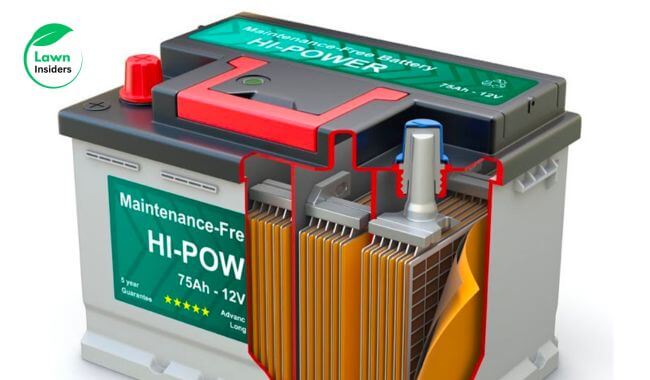Robotic Lawn Mowers Buying Guide

Robotic lawnmowers are the future wave because they make lawn care easier and more efficient. In this in-depth guide, we’ll cover everything you need to know. To make a smart choice when shopping for a robotic lawn mower.
These mowers use sensors and algorithms to navigate around your lawn. Further, maintain a consistent cutting height, ensuring an evenly cut and well-manicured lawn.
Robotic lawn mowers are convenient, time-saving, and environmentally friendly, using less energy and emitting fewer emissions than gas-powered mowers.
Suppose you’re looking for an efficient, hassle-free way to maintain your lawn. A robotic lawn mower may be a good option to consider.
Before purchasing a robotic lawn mower, consider the following things to ensure it’s smart. Here we have explained the following points in detail.
- Area Capacity of Robotic Lawn Mower
- Battery Type of a Robotic Lawn Mower
- Cutting Width of a Robotic Lawn Mower
- Blade Type of a Robotic Lawn Mower
- Weight of a Robotic Lawn Mower
- Charging Time of a Robotic Lawn Mower
- Battery Power of a Robotic Lawn Mower
- Warranty of Robotic Lawn Mower
Let’s cover all these points deeply so you can easily buy any robotic lawn mower.
Area Capacity of Robotic Lawn Mower:
The area capacity of a robotic lawn mower refers to the maximum lawn size that the mower can mow. This typically measures in square feet or acres, and it is an important factor to consider when choosing a robotic lawn mower.
A combination of factors determines the area capacity of a robotic lawn mower. Which includes the size of the mower’s cutting deck, its runtime, and the speed at which it can travel. Some mowers are for small lawns, while others are better for larger lawns.
When shopping for a robotic lawn mower. Consider the size of your lawn and choose a mower capable of covering the entire area. Suppose you have a large lawn and consider looking for a mower with a larger area capacity and a longer runtime.
Other factors may also affect the area capacity of a robotic lawn mower. Such as the terrain of your lawn and the presence of obstacles.
If you want to be sure something works properly. Look at the manufacturer’s instructions for more detailed information about the area capacity of a specific mower.

Battery Type of Robotic Lawn Mower:
A few different types of batteries are in use in robotic lawnmowers. These include lead-acid, nickel-cadmium (NiCd), and lithium-ion (Li-ion) batteries.
Lead acid batteries:
These are a type of rechargeable battery that uses lead and sulfuric acid to store energy. These batteries are relatively inexpensive and have a relatively long lifespan. But they are also heavy and can be prone to sulfation (a build-up of lead sulfate on the battery plates).

Nickel cadmium batteries:
These are another type of rechargeable battery that uses nickel oxide hydroxide and metallic cadmium as electrodes. These batteries are generally more expensive than lead-acid batteries. But they are also more durable and have a higher energy density.

Lithium ion batteries:
These are the newer rechargeable battery that uses lithium ions to store energy. These batteries are lighter and more compact than lead-acid batteries. Further, they have a higher energy density and a longer lifespan. However, they are also more expensive and can be more sensitive to temperature changes.
When buying a robotic lawn mower, it’s important to consider the type of battery it uses, runtime, charging time, and lifespan. Keep in mind that different types of batteries may have different maintenance requirements.
Cutting Width of Robotic Lawn Mower:
Each maneuver of a robotic lawn mower cuts a specific width. This typically measures in inches, and it is an important factor to consider when choosing a robotic lawn mower.
A wider cutting width means that the mower can cover more ground with each pass, which can be more efficient if you have a large lawn. On the other hand, a narrower cutting width may be more suitable for smaller lawns or navigating tight corners and obstacles.
When shopping for a robotic lawn mower. It’s good to consider the size of your lawn and choose a mower with a cutting width appropriate for your needs.
Always remember that other factors also affect the cutting width, such as the type of grass it is for cutting and the terrain of your lawn. It’s also very helpful to check the manufacturer’s specifications for more detailed information about the cutting width of a specific mower.
Blade Type of a Robotic Lawn Mower:
A robotic lawn mower’s blade type refers to its grass-cutting blades. A few different types of blades operate in robotic lawnmowers, including rotary blades, mulching blades, and recycling blades.
Rotary Blades:
These are the most common blades used in robotic lawnmowers. These blades rotate at high speeds and use a scissor-like motion to cut grass. Rotary blades are generally suitable for cutting a wide range of grass types. They are effective at producing a clean and even cut.
Recycling Blades:
These are similar to mulching blades, but they are for chopping the grass clippings into even finer pieces. These blades are often in use in mowers with a grass-clipping bag or collection system, as they can help reduce the volume of clippings that need to be collected.
Mulching Blades:
These are for cutting grass into fine clippings that can be left on the lawn to decompose. These blades typically have a serrated edge that helps to shred the grass clippings into small pieces. Mulching blades are a good choice to reduce the amount of grass clippings you need to dispose of, as they can help create a natural fertilizer for your lawn.
Weight of Robotic Lawn Mower:
The weight of a robotic lawn mower is typically measured in kilograms (Kg.) or pounds (LBS.). To convert the weight of a robotic lawn mower from kilograms to pounds, you can use the following formula:
Weight (Lbs.) = Weight (Kg.) X 2.2
For example, if the weight of a robotic lawn mower is 18 kg, you can convert it to pounds using the following calculation:
Weight (Lbs.) = 18 kg x 2.2 = 39.6 Weight (LBS)
Remember that the weight of a robotic lawn mower can vary depending on the size of the mower, the type of battery it uses, and the other components it includes. Check the manufacturer’s specifications for the exact weight of a specific mower.
Charging Time of Robotic Lawn Mower:
The charging time of a robotic lawn mower defines how long it takes to charge the mower’s battery fully. This is typically measured in hours or minutes, and it is an important factor to consider when choosing a robotic lawn mower.
The charging time of a robotic lawn mower can vary depending on the type of battery it uses and the size of the battery. For example, a mower with a larger battery may take longer to charge than a smaller one.
When shopping for a robotic lawn mower, consider the charging time of the mower and choose one suitable for your needs. Keep in mind that the charging time of a mower can also be affected by other factors, such as the condition of the battery and the charging method.
Check the manufacturer’s specifications for more detailed information about the charging time of a specific mower.
Battery Power of Robotic Lawn Mower:
The battery power of a robotic lawn mower refers to the amount of energy that is stored in the mower’s battery. This is typically measured in watt-hours (WH) or ampere-hours (Ah), and it is an important factor to consider when choosing a robotic lawn mower.
The battery power of a robotic lawn mower can affect the mower’s runtime, which is the amount of time it can operate on a single charge. A mower with a higher battery power may have a longer runtime than one with a lower one.
The battery power of a robotic lawn mower can also affect the mower’s performance, as a higher battery power may allow the mower to operate at a higher speed or handle steeper slopes more easily.
When shopping for a robotic lawn mower, it’s a good idea to consider the battery power of the mower and choose one that is suitable for your needs.
Price Range of Robotic Lawn Mower:
The price range of robotic lawn mowers can vary widely, depending on several factors, including the size of the mower, its features, the brand, and the quality of the components.
In general, smaller and simpler mowers are less expensive, while larger and more feature-rich mowers are more expensive.
You can typically find basic robotic lawn mowers for $800-$1,000, while more advanced mowers with more features and higher quality components can cost upwards of $2,000 or more.
Warranty of Robotic Lawn Mower:
A warranty is a guarantee offered by the manufacturer of a product, typically for a specific period, that covers any defects or malfunctions that may occur. Most robotic lawnmowers come with a warranty, and it is good to consider the terms when shopping for a mower.
The length of the warranty and the type of coverage it provides can vary depending on the manufacturer and the specific mower. Some warranties may cover only certain components, while others may cover the entire mower.
Some warranties may be limited to a specific period, while others may be more comprehensive and cover the mower for longer.
It’s good to read the terms of the warranty carefully and understand what is and isn’t covered. Some warranties may require you to register the mower or perform certain maintenance tasks to be eligible for coverage.
Conclusion:
In conclusion, buying a robotic lawn mower is a game-changer for anyone looking for an easy and efficient way to keep their lawn looking great.
You may save time and effort with the help of these cutting-edge devices. You can also take pride in a well-manicured lawn. Allow modern lawn care technology to perform the heavy lifting so you can sit back and bask in the glory of a well-manicured lawn.
Say farewell to backbreaking labor and welcome a more sustainable, high-tech approach to maintaining a beautiful lawn.
